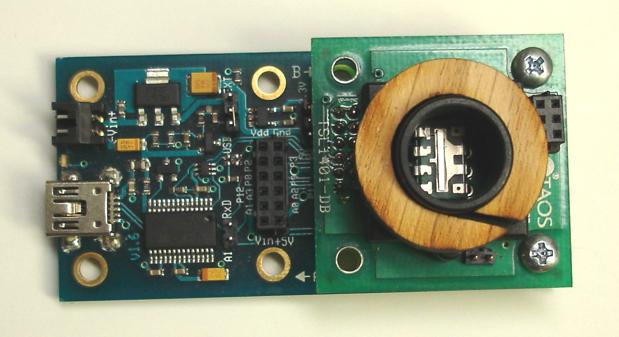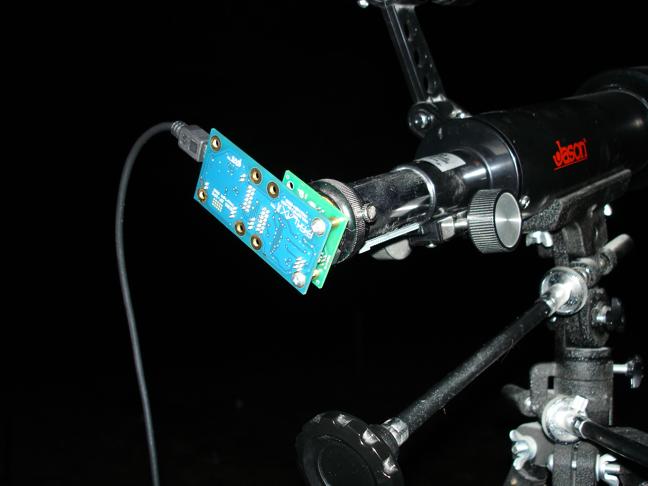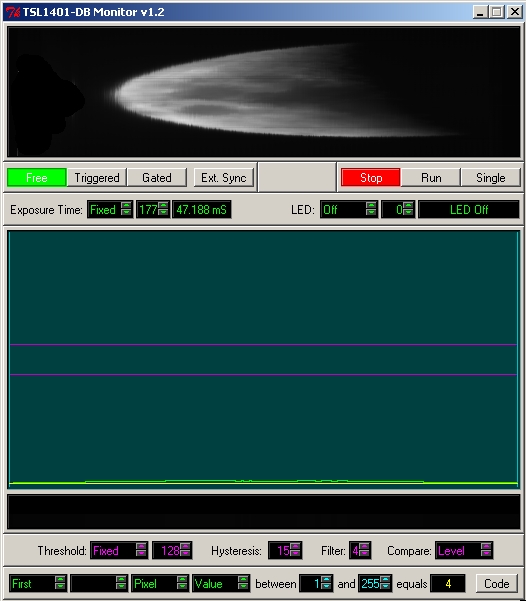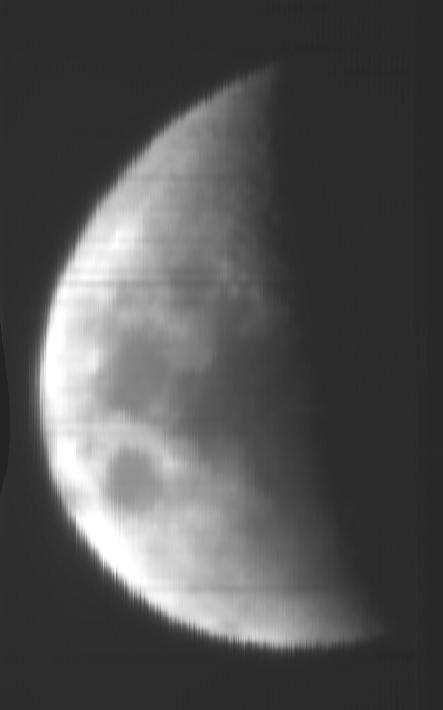Astrophotography with the TSL1401-DB
 Phil Pilgrim (PhiPi)
Posts: 23,514
Phil Pilgrim (PhiPi)
Posts: 23,514
The sensor in the TSL1401-DB uses a 128x1 array of photosensitive pixels in order to "see" in one dimension. To form a two-dimensional image of a subject, it is necessary for either the sensor or the subject to be moving in a direction perpendicular to the sensor's array axis. By taking a series of snapshots and laying them side-by-side, a two-dimensional image can be formed.
Astronomical objects apprear to move in circles around true north, due to the earth's rotation. However, objects close to the ecliptic, such as the moon and planets appear to move in straighter lines. This apparent straight-line motion is perfect for forming images of these objects with a linescan sensor. All you have to do is focus the telescope, aim it just ahead of the object's apparent trajectory, and let it drift through the field of view as the earth rotates.
I did that this evening, with the moon as my subject. The telescope I used was a cheap department store variety with a 2.5" objective lens. To form an image on the sensor it was necessary to remove both the telescope's eyepiece and the TSL1401-DB's lens, so the image could be formed on the sensor at the objectvie lens's primary focus. I had to make an adapter out of wood with my laser cutter that held the TSL1401-DB's lensholder in the telescope's eyepiece barrel. The adapter and TSL1401-DB are shown here, along with the MoBoStamp-pe, which was used to drive the TSL1401 and send data to a laptop computer:

Here is what the entire unit looks like attached to the telescope:

The eyepiece barrel's setscrew clamps down on the wooden adapter and holds everything in place.
I didn't have to use any special software to capture an image. The monitor software downloadable from the TSL1401-DB's product page is all that was required. It took quite a bit of fiddling to get everything lined up properly and focused. I missed a little on getting the sensor aligned perpendicular to the ecliptic, so the final image is a little skewed as a result. My focus could have been a bit better, too.
Here's what the image looks like in the monitor program:

And here's what it looks like once I cropped it and stretched it vertically to correct the aspect ratio:

A better telescope with a more stable tripod would certainly have helped the overall image quality. And, of course, one can never have too many pixels for something like this. Nonetheless, it seems to have have been a worthwhile experiment!
-Phil
Astronomical objects apprear to move in circles around true north, due to the earth's rotation. However, objects close to the ecliptic, such as the moon and planets appear to move in straighter lines. This apparent straight-line motion is perfect for forming images of these objects with a linescan sensor. All you have to do is focus the telescope, aim it just ahead of the object's apparent trajectory, and let it drift through the field of view as the earth rotates.
I did that this evening, with the moon as my subject. The telescope I used was a cheap department store variety with a 2.5" objective lens. To form an image on the sensor it was necessary to remove both the telescope's eyepiece and the TSL1401-DB's lens, so the image could be formed on the sensor at the objectvie lens's primary focus. I had to make an adapter out of wood with my laser cutter that held the TSL1401-DB's lensholder in the telescope's eyepiece barrel. The adapter and TSL1401-DB are shown here, along with the MoBoStamp-pe, which was used to drive the TSL1401 and send data to a laptop computer:
Here is what the entire unit looks like attached to the telescope:
The eyepiece barrel's setscrew clamps down on the wooden adapter and holds everything in place.
I didn't have to use any special software to capture an image. The monitor software downloadable from the TSL1401-DB's product page is all that was required. It took quite a bit of fiddling to get everything lined up properly and focused. I missed a little on getting the sensor aligned perpendicular to the ecliptic, so the final image is a little skewed as a result. My focus could have been a bit better, too.
Here's what the image looks like in the monitor program:
And here's what it looks like once I cropped it and stretched it vertically to correct the aspect ratio:
A better telescope with a more stable tripod would certainly have helped the overall image quality. And, of course, one can never have too many pixels for something like this. Nonetheless, it seems to have have been a worthwhile experiment!
-Phil






Comments
Thanks Phil.
agfa
-Phil
I was just posting to the ARLISS team (thread in Stamps in Class) about the great night I had stargazing on Thursday night, with my cheap little 3" "Goto" refractor, which I chose simply because I knew I WOULD haul it along with me on camping trips and other trips out to dark sky areas. Of course I'd have loved to have gathered more light, but I know myself well enough to know I wouldn't bother with a large scope on a night like that (esp. knowing that I could just sit and watch the Perseids with the naked eye).
Are there similar sensors with more pixels? Or is something else the limiting factor? This is a really interesting idea that could be turned into a REALLY cheap astro imager, I'd imagine.
My objective, of course, was to show what could be done with stock Parallax products.
But, yes, you can get linear array sensors with thousands of pixels. TAOS makes CMOS sensor modules comprising up to twelve TSL1401 dies lying end-to-end without gaps. But the physical array length, at 8mm per die, is way too big for an app like this. Their TSL1402 (256 pixels) is probably the practical limit. Hammamatsu and Fairchild, for example, make CCD versions with more pixels and finer pixel pitches. CCD sensors are more difficult to drive and interface to than CMOS sensors, though.
The other issue is sensitivity and exposure time. The TSL1401 works fine with bright objects like the moon (and maybe Jupiter and Venus), but the requisite exposure times for dimmer objects, using a small aperture telescope, would be too long to get enough exposures to form a reasonable 2D image as the subject drifts by. (This could be improved threefold in my setup, BTW, since the stock AVR capture firmware for the MoBo uses Vdd as the ADC reference. Once could also use he built-in 1.1V reference, at the possible expense of a higher noise floor for the conversion.)
Most digital astrophotography is done with a chilled 2D CCD array and long exposure times, while the sensor is held on-target by a separate dynamic tracking sensor coupled to the telescope's equatorial drive motor. The beauty of a linear array, of course, is that it can be used with cheap telescope mounts that lack a motor drive.
-Phil
Humanoido
The image is surprisingly good actually. Achieving focus would be near impossible, I don't know how you got it as close as you did.
-Phil
I would like to save the image that is being scanned by the camera as raw data and making a TIFF and I am wondering how you took the image from your camera got it into a jpg form and stretched it out.
Thanks,
Dawn.
I did a screen grab from the monitor program and processed the image in Corel PhotoPaint.
-Phil
Do you know how or where I can save the raw data and make it into a tiff? I want to analyze image in imagej as a tiff and have not been able to find any information on how to do that.
Thanks,
Dawn.